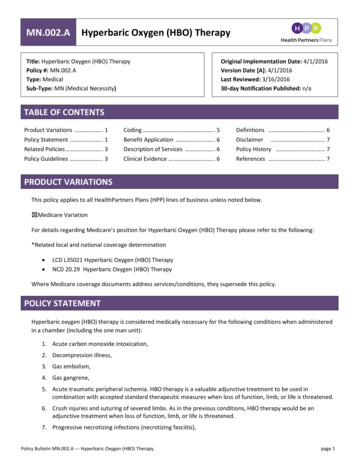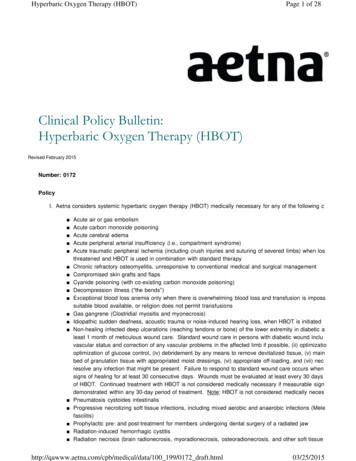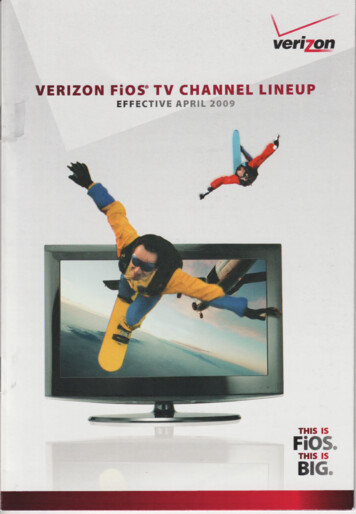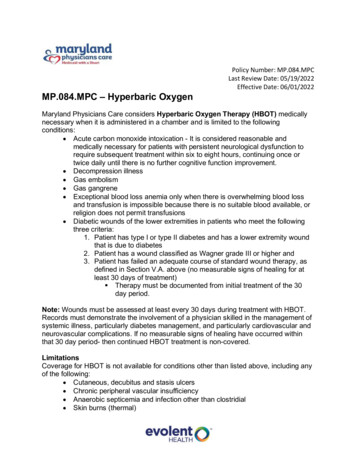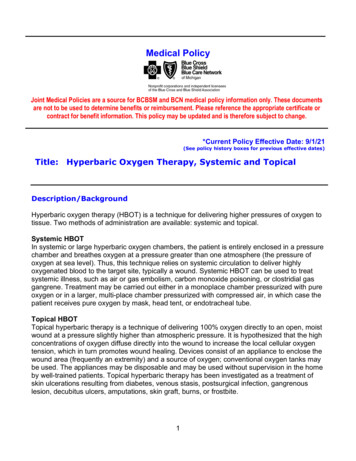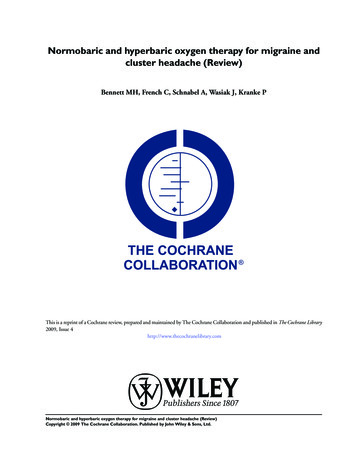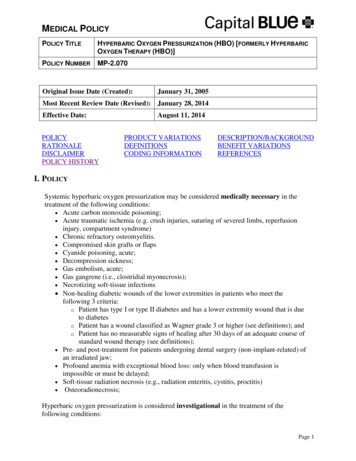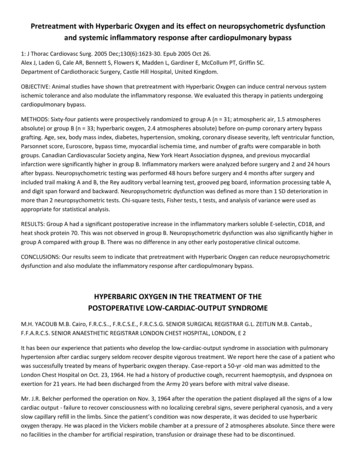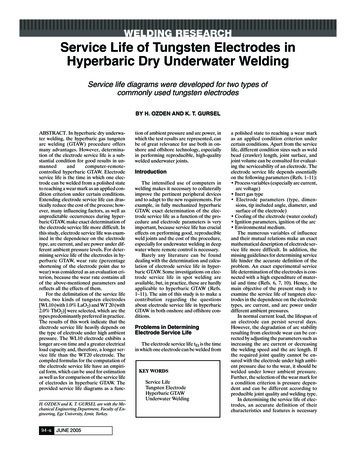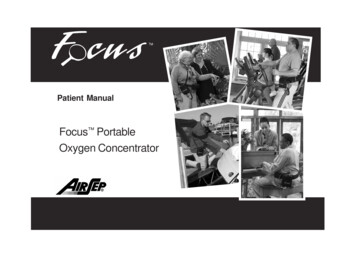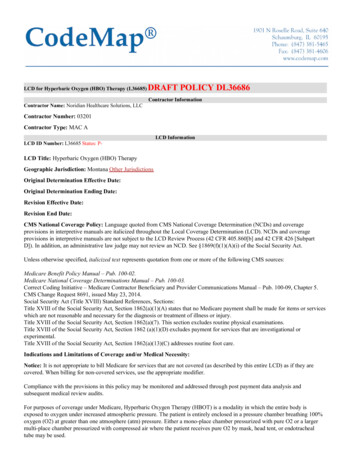
Transcription
LCD for Hyperbaric Oxygen (HBO) Therapy (L36685)DRAFT POLICY DL36686Contractor InformationContractor Name: Noridian Healthcare Solutions, LLCContractor Number: 03201Contractor Type: MAC ALCD InformationLCD ID Number: L36685 Status: P-LCD Title: Hyperbaric Oxygen (HBO) TherapyGeographic Jurisdiction: Montana Other JurisdictionsOriginal Determination Effective Date:Original Determination Ending Date:Revision Effective Date:Revision End Date:CMS National Coverage Policy: Language quoted from CMS National Coverage Determination (NCDs) and coverageprovisions in interpretive manuals are italicized throughout the Local Coverage Determination (LCD). NCDs and coverageprovisions in interpretive manuals are not subject to the LCD Review Process (42 CFR 405.860[b] and 42 CFR 426 [SubpartD]). In addition, an administrative law judge may not review an NCD. See §1869(f)(1)(A)(i) of the Social Security Act.Unless otherwise specified, italicized text represents quotation from one or more of the following CMS sources:Medicare Benefit Policy Manual – Pub. 100-02.Medicare National Coverage Determinations Manual – Pub. 100-03.Correct Coding Initiative – Medicare Contractor Beneficiary and Provider Communications Manual – Pub. 100-09, Chapter 5.CMS Change Request 8691, issued May 23, 2014.Social Security Act (Title XVIII) Standard References, Sections:Title XVIII of the Social Security Act, Section 1862(a)(1)(A) states that no Medicare payment shall be made for items or serviceswhich are not reasonable and necessary for the diagnosis or treatment of illness or injury.Title XVIII of the Social Security Act, Section 1862(a)(7). This section excludes routine physical examinations.Title XVIII of the Social Security Act, Section 1862 (a)(1)(D) excludes payment for services that are investigational orexperimental.Title XVIII of the Social Security Act, Section 1862(a)(13)(C) addresses routine foot care.Indications and Limitations of Coverage and/or Medical Necessity:Notice: It is not appropriate to bill Medicare for services that are not covered (as described by this entire LCD) as if they arecovered. When billing for non-covered services, use the appropriate modifier.Compliance with the provisions in this policy may be monitored and addressed through post payment data analysis andsubsequent medical review audits.For purposes of coverage under Medicare, Hyperbaric Oxygen Therapy (HBOT) is a modality in which the entire body isexposed to oxygen under increased atmospheric pressure. The patient is entirely enclosed in a pressure chamber breathing 100%oxygen (O2) at greater than one atmosphere (atm) pressure. Either a mono-place chamber pressurized with pure O2 or a largermulti-place chamber pressurized with compressed air where the patient receives pure O2 by mask, head tent, or endotrachealtube may be used.
Hyperbaric Oxygen Therapy serves four primary functions:1.2.3.4.It increases the concentration of dissolved oxygen in the blood, which augments oxygenation to all parts of the body; andIt replaces inert gas in the bloodstream with oxygen, which is then metabolized by the body; andIt may stimulate the formation of a collagen matrix and angiogenesis; andIt acts as a bactericide for certain susceptible bacteria.Developed as treatment for decompression illness, this modality is an established therapy for treating medical disorders such as carbonmonoxide poisoning, gas gangrene, acute decompression illness and air embolism. HBO is also considered acceptable as adjunctive therapy inthe treatment of sequelae of acute vascular compromise and in the management of some disorders that are refractory to standard medical andsurgical care or the result of radiation injury.The following conditions meet coverage indications per National Coverage Determination (NCD 20.29)Covered Conditions:Program reimbursement for HBO therapy is limited to the following te carbon monoxide intoxication,Decompression illness,Gas embolism,Gas gangrene,Acute traumatic peripheral ischemia. HBO therapy is a valuable adjunctive treatment to be used in combination with accepted standardtherapeutic measures when loss of function, limb, or life is threatened.Crush injuries and suturing of severed limbs. As in the previous conditions, HBO therapy would be an adjunctive treatment when loss offunction, limb, or life is threatened.Progressive necrotizing infections (necrotizing fasciitis),Acute peripheral arterial insufficiency,Preparation and preservation of compromised skin grafts (not for primary management of wounds),Chronic refractory osteomyelitis, unresponsive to conventional medical and surgical management,Osteoradionecrosis as an adjunct to conventional treatment,Soft tissue radionecrosis as an adjunct to conventional treatment,Cyanide poisoning,Actinomycosis, only as an adjunct to conventional therapy when the disease process is refractory to antibiotics and surgical treatment,Diabetic wounds of the lower extremities in patients who meet the following three criteria:a. Patient has type I or type II diabetes and has a lower extremity wound that is due to diabetes;b. Patient has a wound classified as Wagner grade III or higher; andc. Patient has failed an adequate course of standard wound therapy.The use of HBO therapy is covered as adjunctive therapy only after there are no measurable signs of healing for at least 30 - days of treatmentwith standard wound therapy and must be used in addition to standard wound care. Standard wound care in patients with diabetic woundsincludes: assessment of a patient’s vascular status and correction of any vascular problems in the affected limb if possible, optimization ofnutritional status, optimization of glucose control, debridement by any means to remove devitalized tissue, maintenance of a clean, moist bed ofgranulation tissue with appropriate moist dressings, appropriate off-loading, and necessary treatment to resolve any infection that might bepresent. Failure to respond to standard wound care occurs when there are no measurable signs of healing for at least 30 consecutive days.Wounds must be evaluated at least every 30 days during administration of HBO therapy. Continued treatment with HBO therapy is not coveredif measurable signs of healing have not been demonstrated within any 30-day period of treatment.SPECIFIC CONDITIONSThe guidelines below are presented relative to specific treatment conditions and include criteria for diagnosis with expected frequency andduration of treatment.1. Patients manifesting signs and symptoms of serious carbon monoxide poisoning (CO) (e.g., transient or prolonged unconsciousness,neurologic signs, cardiovascular dysfunction or severe acidosis) should be referred for HBO therapy regardless of COHb level, asCOHb levels do not correlate with signs and symptoms. However, referral of patients with COHb 25% is reasonable or whenneuropsychological testing is abnormal. Treatment should begin at the time of diagnosis. Optimal dosing (pressure, duration, frequency)is not known but optimal benefit from HBOT occurs in those treated with the least delay after exposure. The majority of facilities offersingle session HBOT to CO-poisoned patients; however, in selected patients repeated treatments may yield better outcome. Severalprotocols have been developed; however, most offer 2.8-3.0 ATA initial compression, then 2 ATA for 120-140 minutes, occasionallyfollowed by additional 2 sessions for 90 minutes in six to twelve hour intervals, without further HBOT. Even with appropriate HBOTsome patients will develop cognitive or other neurological sequelae which does not appear to be altered by continued HBOT. Childrenmay be treated safely but may still have long-term problems. Pregnant women may be treated safely. Evidence of fetal distress is anindication of need for HBOT despite normal carboxyhemoglobin levels and the absences of symptoms in the mother.
2. Decompression Illness (Sickness) is the result of inert gas bubbles in tissues and/or blood causing organ dysfunctions. It can be causedby a reduction in ambient pressure during ascent from a dive, rapid altitude excursion or a hyperbaric/hypobaric chamber. The resultingclinical manifestations include joint pain (bends), cutaneous eruptions or rashes, neurological dysfunction, cardiorespiratory symptomsand pulmonary edema, shock, and death. Diagnosis of Decompression injury is made on the basis of signs and symptoms after a dive oraltitude exposure, which manifest as paresthesias, hypesthesia, joint pain, skin rash and malaise while more serious signs may be motorweakness, ataxia, dyspnea, hypotension, and shock leading to death. All symptoms manifest within 24 hours unless there is an additionalinsult. Treatment of choice for decompression illness is HBO therapy. The result is immediate reduction in the volume of bubbles.Recommended treatment is administration of 100% oxygen (1 ATA) at ground level or at elevated pressure (HBO) when feasible. Themajority of symptoms will resolve with supportive measures; however, it is generally agreed that complete resolution is most likely tooccur with HBO therapy. The treatment prescription is highly variable and case specific; however the great majority of cases respond to asingle treatment. Although a small minority of divers with severe neurological injury may not reach a clinical plateau until 15-20repetitive treatments have been administered ( 2.82 ATA), formal statistical analysis supports the efficacy of no more than 5-10repetitive treatments for most individuals. A summary of current recommendations for adjunctive therapy is available on the Underseaand Hyperbaric Society website (http://www.uhms.org).3. Air or Gas Embolism (AGE) occurs when gases enter the venous or arterial vasculature embolizing in a large enough volume tocompromise the function of an organ or body part and results in ischemia to the affected areas. Arterial gas embolism classicallydescribed during submarine escape training can also occur as a result of blast injury, mechanical ventilation, penetrating chest trauma,chest tube placement and bronchoscopy. Venous gas embolism classically occurred after compressed gas diving or rapid exposure toaltitude; however, medical intervention is the most common cause. Accidental intravenous air injection occurs with cardiopulmonarybypass accidents, gastrointestinal endoscopy, hydrogen peroxide irrigation, arthroscopy, central venous catheter placement ordisconnection, endoscopic or laparoscopic procedures, and dental procedures, to name only a few possible scenarios. Clinical deficitscan occur after intra-arterial injections of very small volumes of air while larger intravenous injection is often asymptomatic.Presumptive diagnosis of AGE is made on the basis of clinical criteria. Diagnostic imaging is unnecessary as it has low diagnosticsensitivity (and may delay therapy) but may exclude other etiologies for the symptoms. HBO therapy, the treatment of choice, is mosteffective when initiated early. Immediate treatment is airway management, maintenance of blood pressure and administration of highoxygen concentration with HBOT as quickly as the patient can be stabilized. Administration of repetitive treatments is recommendeduntil there is no further improvement, typically after no more than one to two hyperbaric sessions, but occasionally as many as five.Standard treatment schedules are those of the U.S. Navy (U.S. Navy Diving Manual available at http:// www.supsalv.org/ ).4. Clostridial Myositis and Myonecrosis (Gas Gangrene) is an acute, rapidly invasive infection of the muscle characterized by profoundtoxemia, extensive edema, massive death of tissue and variable degree of gas production. The diagnosis of gas gangrene is based onclinical data supported by the demonstration of Gram-positive rods from the fluids of the involved tissues as well as a virtual absence ofleukocytes. Culture results are unpredictable while sialidase immunoassays may allow accurate identification of the Clostridium species.Tissue gas seen in a feather-like pattern radiologically, associated with crepitus, is an early and characteristic sign. An associated thinserosanguinous exudate with a sickly, sweet odor associated with disproportionate pain is essentially diagnostic. The onset of gangrenecan occur one to six hours after injury and presents with severe and sudden pain at the infected area. The goal of HBO therapy is to stopalpha-toxin production, requiring tissue oxygen concentrations of 250 mm Hg, thereby inhibiting further bacterial growth at which pointthe body can use its own host defense mechanisms. HBO treatment starts as soon as the clinical picture presents and is supported by apositive Gram-stain. The greatest reduction in mortality results from treatment utilizing HBOT, antibiotic therapy and surgery.Debridement of necrotic tissue can be performed between HBO treatments when clear demarcation between dead and viable tissue isevident. The usual treatment consists of oxygen administered at 3.0 ATA pressure for 90 minutes three times in the first 24 hours. Overthe next four to five days, treatment sessions twice a day are usual, for up to 15 sessions. The actual decision for termination of therapy isdependent upon the patient’s response to HBO therapy.5. Crush injuries and suturing of severed limbs, acute traumatic peripheral ischemia (ATI), and acute peripheral arterial insufficiencyassociated with arterial embolism and thrombosis share the common pathophysiology of Reperfusion Injury. Acute traumatic ischemia isthe result of injury by external force or violence, compromising circulation to an extremity. Similarly, acute peripheral arterialinsufficiency (APAI) is acute onset of ischemia of an extremity secondary to arterial embolus or thrombus. Presentation is within hoursto a few days after the event. The extremity is then at risk for tissue loss and necrosis with subsequent amputation. Emergent surgicalintervention is imperative if the extremity is to be salvaged. Secondary complications are frequently seen: infection, non-healingwounds, and non-united fractures despite the restoration of circulation, due to the reactive edema which presents post restoration ofblood flow. The goal of HBO therapy is to enhance oxygen at the tissue level to support viability during the post injury period. Whentissue oxygen tensions fall below 30mm Hg, the body’s ability to respond to infection and wound repair is compromised. Using HBO at2-2.4 ATA, the tissue oxygen tension is raised to a level such that the body’s responses can become functional again. The benefits ofHBO therapy for this indication are:Increased oxygen delivery per unit of blood flow or enhanced tissue oxygenation,Edema reduction, andReduction in the complication rates for infection, nonunion and amputation.The use of HBOT is expected to be in support of the definitive surgical procedure (re-implantation, embolectomy,thrombectomy, decompression of a compartment syndrome or removal of the flow limiting condition of the limb).HBO is indicated within the first 4-6 hours of the acute event, and only after documented restoration of the blood circulation. Forreperfusion injuries, crush injuries or pending compartment syndrome, therapy beyond 2-3 days has not shown beneficial salvage orfurther limit to loss of tissue or limb. Post fasciotomy demarcation may require up to 2 weeks of twice daily treatments prior todefinitive determination of benefit. Therapy initiated or continued longer than two weeks from the inciting injury has not beendetermined to be beneficial. Beyond two weeks the condition is considered chronic and would not be considered reasonable andnecessary. The usual treatment schedule is two to three 90 minute treatment periods daily for the first 24- 48 hours. Additional 90 minutetreatment sessions daily for the next 2-3days may be required. For acute traumatic peripheral ischemia, crush injuries and recently
restored severed limbs, with resultant compartment syndromes, HBOT is a valuable adjunctive treatment to be used in combination withaccepted standard surgical and pharmacologic therapeutic measures, when loss of function, limb, or life is threatened. Edema or aftereffects of acute arterial insufficiency may be treated by limited HBO therapy similar to that of crush injuries or acute ischemia withreperfusion signs, if they are persistent after reconstructive surgery has restored large vessel function and perfusion. Reperfusion injurytreatment with HBOT is not expected to exceed 15 sessions over the course of a 3-7 day acute treatment.6. The principal treatment for Progressive Necrotizing Infections (Necrotizing Fasciitis) is surgical debridement and systemic antibiotics.HBO therapy is recommended as an adjunct only in those settings where mortality and morbidity are expected to be high despiteaggressive standard treatment. Progressive necrotizing fasciitis is a relatively rare infection. It is usually a result of a group Astreptococcal infection beginning with severe or extensive cellulitis that spreads to involve the superficial and deep fascia, producingthrombosis of the subcutaneous vessels and gangrene of the underlying tissues. A cutaneous lesion usually serves as a portal of entry forthe infection, but sometimes no such lesion is found. It may be confused with Clostridial infection though seldom produces gas in thetissues. The histologic hallmark is extensive inflammation and necrosis of the subcutaneous fat, fascia and muscle. Numerous bacterialtypes may produce bullous lesions with foul or fermented aroma. Hyperbaric oxygen may be a beneficial adjunct for a subset of patientswith anaerobic gram negative necrotizing fasciitis.The recommended HBO treatment protocol is 90 minutes at 2.5 ATA every 8 hours for the first day in conjunction with surgicaldebridement of infected and necrotic tissue, and then twice daily for a maximum of 10 treatments.7. Preparation and preservation of compromised skin grafts utilizes HBO therapy for graft salvage in cases where hypoxia or decreasedperfusion has compromised viability acutely. This indication is “not for primary management of wounds,” i.e. empiric treatment ofprophylactic maintenance of split thickness skin grafts placed on wounds or operative sites (Mohs). Substantial data suggests HBOtherapy may improve composite graft survival in the immediate postoperative period when viability appears threatened due to amechanical complication. It is not indicated to correct the mechanical complication but may be adjunctive therapy once the “mechanical”problem has been corrected and the graft is jeopardized by sequella for which HBOT has an established beneficial effect. Coveredservices require the presence of a graft (flap) with confirmed initial viability, followed by evidence of compromise post correction of theinciting mechanical event.Bioengineered or allogeneic skin substitutes and traditional split thickness skin grafts placed primarily for wound coverage do not meetCMS NCD 20.29 interpretation for coverage. “The covered indication requires that there be a compromised skin graft” per Transmittal129, 10/9/2000, Program Memorandum AB-00-15, CR 1138. HBO therapy is not considered reasonable and necessary for the initialpreparation of the body site for a graft (prior to grafting) except as covered for other entities (radionecrosis, resistant osteomyelitis,neuropathic ulcers, etc.).Treatments are given intensively initially for up to 72 hours followed by re-evaluation of the wound. It is not unusual to receive 2-3treatments per day for up to 3 days post creation of the graft when viability appears threatened. When the graft appears stable, treatmentsare reduced to daily or discontinued. The number of sessions provided to enhance graft survival is not expected to exceed 20.8. Chronic refractory osteomyelitis persists or recurs following appropriate interventions. These interventions include the prolonged useof antibiotics, drainage of the abscess, immobilization of the affected extremity, and surgical debridement with removal of as much ofinfected bone matrix as possible.Medicare may cover the adjunctive use of HBO therapy for chronic refractory osteomyelitis that has been shown to be unresponsive toconventional medical and surgical management. Selection of an appropriate antimicrobial regimen requires a culture obtained frominfected bone such as a surgical specimen or biopsy.HBO therapy is an adjunctive therapy used with the appropriate antibiotics and surgical debridement to eliminate the necrotic boneacting as a foreign body. When the site of the bone infection is not amenable to debridement or resection, HBOT may be indicated toenhance systemic therapy though is not indicated as primary therapy alone.HBO treatments are usually delivered daily for a period of 90-120 minutes and it is not unusual to receive daily treatments followingmajor debridement surgery. The usual course of therapy lasts 4-6 weeks with daily sessions lasting 90-120 minutes up to a maximum of60 treatments within a 12 month period. Additional treatments may be considered reasonable and necessary on redetermination.Hyperbaric oxygen therapy is not considered medically reasonable or necessary for treatment of osteomyelitis of small, solid exposedbones of the forefoot and fingers (metatarsal head, phalanges, sesamoid) which are more effectively treated with debridement and receiveminimal benefit from HBOT due to limited perfusion. HBOT is not considered reasonable and necessary for primary or non-adjunctivetreatment of chronic osteomyelitis9. HBO’s use in the treatment of Osteoradionecrosis and Soft Tissue Radiation Injury (Radionecrosis) is one part of an overall plan ofcare that also includes debridement or resection of nonviable tissue in conjunction with antibiotic therapy. A consistent cause and effectof radiation injury is vascular obliteration and stromal fibrosis or scarring; subsequently, the known impact of hyperbaric oxygentherapy, stimulation of angiogenesis, is an important mechanism of recovery. A reduction in fibrosis of soft tissue as well asmobilization and increase of stem cells within radiated tissue has been documented predominantly in animal studies; however, theimpact of HBOT is likely to involve all these mechanisms.HBO treatment can be indicated in the preoperative and postoperative management of existing osteoradionecrosis or soft tissueradionecrosis, but must be utilized as an adjunct to conventional therapy. Beneficiaries suffering from soft tissue damage or bonenecrosis present with disabling, progressive, painful tissue breakdown, bleeding, bowel or bladder dysfunction, wound dehiscence,infection, tissue loss and graft or flap loss.Prerequisite for treatment includes history of radiation treatment to the region of the documented injury, terminating at least 6 months
prior to onset of signs or symptoms and/or planned surgical intervention at the site. Numerous forms of soft tissue radiation necrosis andtreatment with HBOT have been documented with beneficial effect.The goal of HBO treatment is to increase the oxygen tension in both hypoxic bone and tissue to stimulate growth in functioningcapillaries, fibroblastic proliferation and collagen synthesis.The recommended daily treatments are designed around the stages of radionecrosis last 90-120 minutes at 2.0 to 2.5 ATA. The durationof HBO therapy for these patients is highly individualized but is not expected to exceed 4-8 weeks therapy. The Marx mandibularosteoradionecrosis protocol extends from 30-60 treatments based on stage I-III, adhering to the established principle that all necroticbone must be debrided. Soft tissue radionecrosis usually responds with 30-40 treatments, followed by reconstruction if deemednecessary. An additional 10 treatments is usual following the reconstruction for support of the underlying and surrounding tissue. Alltreatment is individualized and should be assessed for benefit and outcome each 30 days.No demonstrable evidence of improvement post two 30 day periods of HBOT (2.0-2.5 ATA, for 90 to 120 minutes, 5 days per week)suggests lack of benefit and subsequent treatments will be denied as not medically reasonable and necessary No benefit has beendemonstrated for treatment of acute radiation injury or burn, usually manifest coincident with radiation therapy or within the ensuing 6months of the therapy.Coverage for osteoradionecrosis of the jaw is limited to cases with evidence of overt fracture or bony resorption. Data to justify HBOTprophylaxis for osteoradionecrosis in a previously irradiated mandible undergoing tooth extraction is lacking at this time; consequentlythis is a non-covered service.HBO is not covered to prepare the patient for dental extraction, when radiation therapy has not been done at least 6 months prior, inorder to prevent the development of osteoradionecrosis.10. Individuals with CO poisoning may also have been exposed to cyanide and the combination may have synergistic toxicity. Severecyanide poisoning is rapidly fatal while symptoms of mild cyanide poisoning may mimic CO poisoning. Along with supportive care(ventilation, supplemental oxygen and blood pressure support) a cyanide antidote may be administered, some of which may yieldunreliable monitoring results (hydroxocobalamin). Nitrites which induce methemoglobinemia, potentially impairs the oxygen-carryingcapacity of hemoglobin and is now considered contraindicated in the setting of concomitant CO poisoning. Treatment protocol anddosing is directed to the Carbon Monoxide poisoning as that for cyanide poisoning appears to be theoretical and not well substantiatedby human studies11. Actinomycosis is a bacterial infection caused by Actinomyces Israelii. Findings include slow growing granulomas that later breakdown, discharging viscid pus containing yellow granules. The treatment includes prolonged administration of appropriate antibioticswith surgical incision and draining of accessible lesions. When the disease process has been shown refractory to antibiotics and surgery,HBO therapy may be considered reasonable and necessary.12. Treatment of diabetic wounds of the lower extremities: Refer to #15 of the covered indications of NCD 20.29 listed in the previoussection of the LCD.Adjunctive treatment of an ulcer of the lower extremity deemed to be secondary to the neuropathic effects of diabetes will be allowed nomore than 40 treatments (90-120 minutes daily) without documentation of improvement. Wound volume or surface area is expected tomeasurably diminish over 30 days of wound care with adjunctive HBOT. Continued treatment with HBO therapy is non-covered ifmeasurable signs of healing have not been demonstrated within any 30-day period of treatment. ”Measurable signs of healing” are bestdefined as specific, documented, clinical evidence of healing. Physician statements should be descriptive and complete with intervalmeasurements to substantiate wound improvement.NOTE: Wagner grades are a commonly used classification system for diabetic wounds and include five grades (Wagner 1981, Cianci1997). The five grades are defined as follows: grade 0 no open lesion; grade 1 superficial ulcer without penetration to deeper layers;grade 2 ulcer penetrates to tendon, bone, or joint; grade 3 lesion has penetrated deeper than grade 2 and there is abscess,osteomyelitis, pyarthrosis, plantar space abscess, or infection of the tendon and tendon sheaths; grade 4 wet or dry gangrene in the toesor forefoot; grade 5 gangrene involves the whole foot or such a percentage that no local procedures are possible and amputation (atleast at the below the knee level) is indicated.NOTE: Failure to respond to standard wound care occurs when there are no measurable signs of healing (per NCD 20.29) for at least 30consecutive days of appropriate wound care during which the patient has documented evidence of “optimization for wound healing” andthere is no appreciable change in the wound. Documentation of all aspects of optimization defined by the NCD (clarified by this LCD)and the absence of improvement in the wound characteristics constitutes stalled wound healing and suggests that it may benefit fromadjunctive HBOT.NOTE: An ankle brachial index of not less than .6 is considered the standard required for healing of a lesion on a diabetic's foot.Alternative measurements of toe pressures, plethysmography or similar demonstration of small vessel perfusion may be considered ifviable results cannot be obtained in the situation of calcified or non-compressible vessels of the foot and ankle. Transcutaneous oxygenmeasurements cannot predict whether a patient will respond to HBOT but may provide insight into the response to HBOT orrevascularization. HBOT should not be used as a substitute for revascularization.NOTE: As with #8 above, standard therapy for osteomyelitis underlying a chronic ulcer, or mal perforans ulcer, includes surgicaldebridement/excision of the infected nidus of bone.Hyperbaric Oxygen Therapeutic Services
Therapeutic services are hospital outpatient services furnished incident to the services of a physician (or NPP) in the treatment of patientsand must be furnished on a physician’s order and delivered under physician supervision.Appropriate “direct physician supervision” is a requirement for Medicare coverage of Hyperbaric Oxygen TherapeuticServices.For therapeutic services furnished after CY2011 and following, whether in the hospital or CAH or in an on-campus or off-campusoutpatient department of the hospital or CAH as defined at 42 CFR 413.65, ”direct supervision” means that the physician (or NPP) mustbe immediately available to furnish assistance and direction throughout the performance of the procedure. It does not mean that thephysician need be physically present in the room where the procedure is performed. While not defined in ter
Contractor Name: Noridian Healthcare Solutions, LLC Contractor Number: 03201 Contractor Type: MAC A LCD Information LCD ID Number: L36685 Status: P- LCD Title: Hyperbaric Oxygen (HBO) Therapy Geographic Jurisdiction: Montana Other Jurisdictions Original Determination Effective Date: Original Determination Ending Date: Revision Effective Date: Revision End Date: CMS National Coverage Policy .
